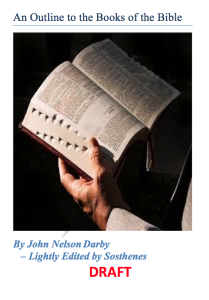The Marriage of the Lamb
The third in our series of forthcoming events is the marriage of the Lamb. Chronologically the Antichrist and the great tribulation probably come first, but I would like to concentrate first on the events which affect the church and the saints of our dispensation:
- The Rapture
- The Judgment Seat of Christ
- The Marriage of the Lamb (this note)
- The Millennium (to be written)
Revelation 19:6-9
| King James Version | Darby Version |
| 6And I heard as it were the voice of a great multitude, and as the voice of many waters, and as the voice of mighty thunderings, saying, Alleluia: for the Lord God omnipotent reigneth.7Let us be glad and rejoice, and give honour to him: for the marriage of the Lamb is come, and his wife hath made herself ready. 8And to her was granted that she should be arrayed in fine linen, clean and white: for the fine linen is the righteousness of saints. 9And he saith unto me, Write, Blessed are they which are called unto the marriage supper of the Lamb. And he saith unto me, These are the true sayings of God. | 6And I heard as a voice of a great crowd, and as a voice of many waters, and as a voice of strong thunders, saying, Hallelujah, for [the] Lord our God the Almighty has taken to himself kingly power.7Let us rejoice and exult, and give him glory; for the marriage of the Lamb is come, and his wife has made herself ready. 8And it was given to her that she should be clothed in fine linen, bright [and] pure; for the fine linen is the righteousnesses of the saints.
9And he says to me, Write, Blessed [are] they who are called to the supper of the marriage of the Lamb. And he says to me, These are the true words of God.
|
The marriage is described in this passage. I have shown the Darby version as there are expressions which he, and several modern translators, believe that the KJV rendering is inaccurate. These are highlighted.
The Current Relationship between Christ and His Church
The church came into existence when the Holy Spirit filled the 120 or so persons who were gathered in the upper room in Acts 2:2, a number that soon grew to 5000. From the start, she was united to Christ, and even at this early date fully capable of fulfilling her function as the wife of Christ.
The epistles often refer to the church as Christ’s body. The body comprises only those who are alive now, not to all who will form the bride. Nevertheless, the relationship between Christ and His assembly is clear: ‘For this cause shall a man leave his father and mother, and shall be joined unto his wife, and they two shall be one flesh. This is a great mystery: but I speak concerning Christ and the church’ (Eph 5:31-32) .
It is not until Revelation that we have the Church described as a bride. His wife had made herself ready, so she was a wife before she was a bride. The church is now the wife looking after her Husband’s affairs in His absence. She is His trustworthy confidante. Although the marriage ceremony has not yet taken place, the relationship already exists. There is perfect unity between Christ and His church. Christendom publicly is something else.
When is The Marriage of the Lamb?
Before the marriage celebration of the Lamb, Babylon – the rival – will have been overthrown and judged.. It says, ‘[the] Lord our God the Almighty has taken to himself kingly power’ (v. 6 Darby). He had taken the power, and was about to reign, but He was not actually reigning. Hence we can say that this event would take place between the great tribulation and the millennium
The judgment seat of Christ, must precede the marriage. No doubt ‘his wife hath made herself ready’ (v. 7) would refer in part to that. What remains is the bride’s bright clothing – the righteousnesses of the saints (v. 8 Darby). – things that they had done which had met with God’s approval. (Note KJV appears wrong again here – most modern translations say ‘righteous deeds or acts’, which is correct – Greek δικαιώματα/dikaiōmata/Strong 1345). What qualifications the bride has!
The Marriage Celebration
When a couple gets married, the persons will not have been united beforehand (at least if they have been conducting themselves according to God’s clear ordering). Traditions might vary, but in any marriage there is generally a legal act and a celebration. The bride is the centre of attention, beautifully dressed (hopefully comelily), and looking her best. A new household is established, the man and the woman having both left their parental homes (see Gen 2:24 and Psalm 45:10). The fact that the Holy Spirit introduced this concept so early in Genesis shows that the marriage relationship was always in God’s mind and purpose.
From what we have seen this will be no ordinary marriage. We might say that legal side has already taken place. Now it is time for a celebration of an existing relationship. Until Satan had been overcome publicly it was not yet the time for her to be seen publicly in her beautiful radiance
It says ‘Blessed are they which are called unto the marriage supper of the Lamb.’ v. 9. Abraham and other Old Testament saints will be there as guests. They are children of the bridechamber, but they are not united to Christ as the church is (see Minstry of James Butler Stoney vol 6 page 116). It has been suggested that the invitees include the king’s daughters and the daughters of Tyre in Psalm 45: 9 & 12.
Jerusalem as the Bride
 The bride is described as a city because of her function of rule. ‘Come hither, I will shew thee the bride, the Lamb’s wife. And he [the angel] carried me away in the spirit to a great and high mountain, and shewed me that great city, the holy Jerusalem, descending out of heaven from God, having the glory of God…’ (Rev 21:9-11). However, this will be seen in the millennium – the bride (or wife) of Christ, already married.
The bride is described as a city because of her function of rule. ‘Come hither, I will shew thee the bride, the Lamb’s wife. And he [the angel] carried me away in the spirit to a great and high mountain, and shewed me that great city, the holy Jerusalem, descending out of heaven from God, having the glory of God…’ (Rev 21:9-11). However, this will be seen in the millennium – the bride (or wife) of Christ, already married.
The holy Jerusalem is, of course, totally different from the millennial Jerusalem on earth, described in Ezekiel 40-44 and many other scriptures. The city we are referring to will not be physically on the earth – indeed its foundations will be visible. Rev 21:6 describes the city as a cube 12,000 cubits (approx. 1380 miles or 2200km) in each dimension.
What is the difference between Christ’s heavenly and earthly bride?
The following table shows the difference between the two:
| The Heavenly Bride | The Earthly Bride | |
| What | The Church or Assembly | Israel |
| Key Scriptures | Rev 19:6-9 | Psalm 45 |
| Where | In heaven – or at least over the earth | On earth (see Ezek 40:2) |
| Jerusalem | The holy city, new Jerusalem, coming down from God out of heaven, prepared as a bride adorned for her husband. (Rev 21:2) | I am returned unto Zion, and will dwell in the midst of Jerusalem: and Jerusalem shall be called a city of truth; and the mountain of the LORD of hosts the holy mountain (Zech 8:3) |
| Relation to Christ | She adores her Head | She worships her Lord |
| When formed | Starting with the Spirit’s coming, complete at the rapture | Before Christ’s appearing and during the tribulation |
Conclusion
We should guard ourselves from applying too much human logic and chronology to these holy matters. I have not wanted to be technical, but have been feeling my way prayerfully through this holy subject. I trust I have covered the matter justly. If any reader feels that I have erred, please write immediately.
But it is wonderful that we are part of this beautiful bride! Magazines are full of pictures of very beautiful women – pictures often enhanced digitally. No such outward improvement will be required for the bride of Christ. She will be just how Jesus wants it.
And we will be part!
God’s blessings
Sosthenes
February 2017


